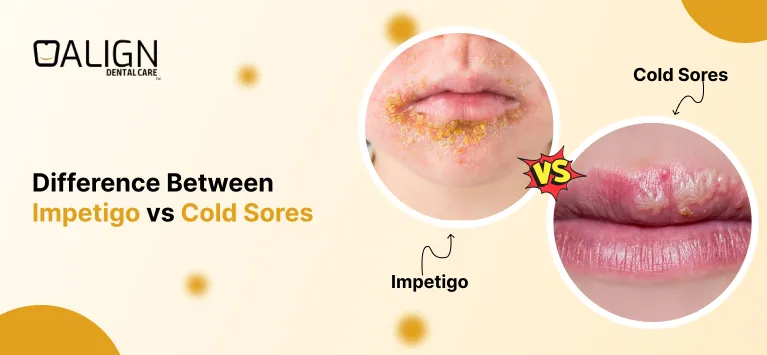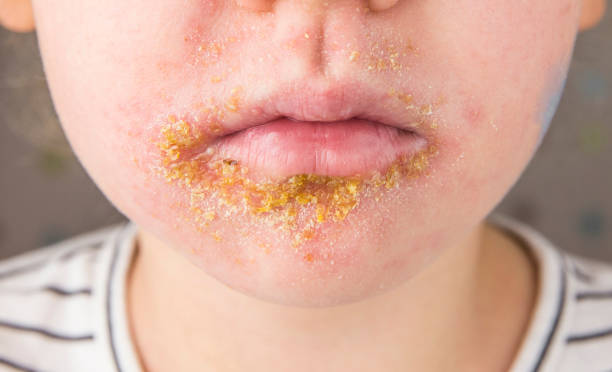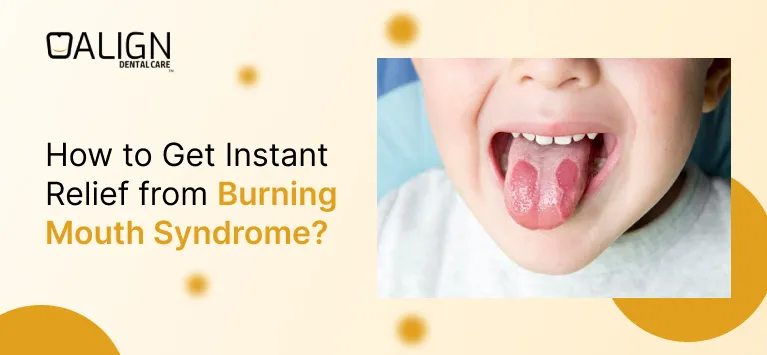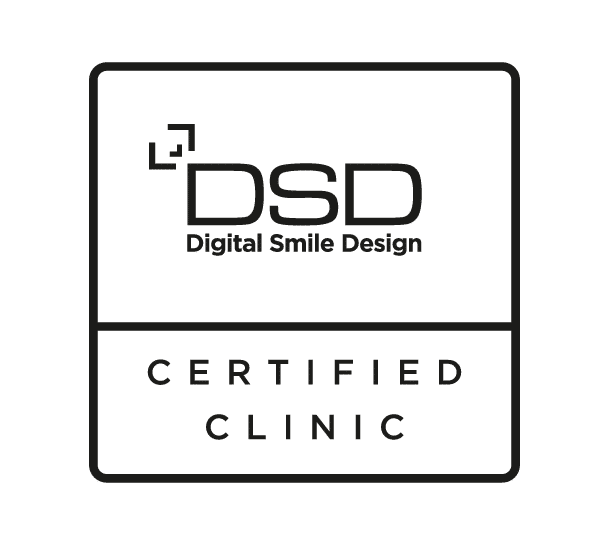
Difference Between Impetigo vs Cold Sores
Impetigo and cold sores are both common and contagious skin conditions that often cause blisters around the mouth, but they differ in causes, symptoms, and treatment. In this blog, we will explore the key differences between impetigo and cold sores, including their causes, symptoms, appearance, and treatments. Understanding these conditions will help you identify them accurately and take the right steps to manage or prevent them.
Table of Contents
Impetigo vs. Cold Sores: Key Differences
Here’s a detailed comparison of impetigo vs cold sores to help you understand their differences.
| Feature | Impetigo | Cold Sores |
| Cause | Bacteria (Staphylococcus aureus or Streptococcus). | Virus (Herpes Simplex Virus, mostly HSV-1). |
| Appearance | Red sores that burst and form honey-colored crusts. | Fluid-filled blisters that scab over. |
| Location | Often around the nose, mouth, hands, and legs. | Usually on the lips or around the mouth. |
| Symptoms | Itchy, mild discomfort; possible swelling. | Tingling or burning sensation; can be painful. |
| Contagion | Through direct contact or shared items. | Spread via saliva, blisters, or direct contact. |
| Treatment | Antibiotics (topical or oral). | Antiviral creams or medications. |
| Duration | Clears in 7–10 days with treatment. | Resolves in 7–14 days; may recur. |
| Reoccurrence | Rare after treatment. | Common due to dormant virus reactivation. |
| Risk Groups | Mostly children; those with skin injuries. | Anyone exposed; triggered by stress or illness. |
| Prevention | Maintain good hygiene, treat wounds quickly. | Avoid direct contact; use sunscreen on lips. |
What Is Impetigo?
Impetigo is a common bacterial skin infection, especially in children. It typically occurs when bacteria enter the skin through cuts, insect bites, or scratches. It is caused by Staphylococcus aureus and Streptococcus pyogenes.
Symptoms of Impetigo
- Red sores or blisters, usually around the nose, mouth, hands, or legs.
- The sores burst, leaving a yellowish or honey-coloured crust.
- Itching and mild discomfort.
- In some cases, swollen lymph nodes near the infection site.
How Does Impetigo Spread?
Impetigo is highly contagious. It spreads through:
- Direct contact with an infected person.
- Sharing towels, clothing, or other personal items.
- Touching surfaces contaminated with the bacteria.
Who Is at Risk?
While anyone can get impetigo, it’s most common in:
- Children aged 2–6 years.
- People with weakened immune systems.
- Those living in close quarters or hot, humid environments.
What Are Cold Sores?
Cold sores, also known as fever blisters, are caused by the herpes simplex virus (HSV), usually HSV-1. They are a viral infections, not bacterial, and often recur throughout a person’s life.
Symptoms of Cold Sores
- Small, fluid-filled blisters, often on the lips or around the mouth.
- A tingling or burning sensation before the blisters appear.
- Blisters that burst and form a scab as they heal.
- Pain or discomfort around the affected area.
How Do Cold Sores Spread?
Cold sores are also highly contagious and spread through:
- Kissing or direct contact with an infected person.
- Sharing utensils, lip balms, or drinks.
- Touching the sores and then touching your face or others.
Who Is at Risk?
Anyone exposed to HSV-1 can get cold sores. They are often triggered by:
- Stress.
- Illness or fever.
- Sun exposure.
- Hormonal changes, like during menstruation.
Key Differences Between Impetigo and Cold Sores
Causes:
What Causes Impetigo?
Impetigo is caused by bacteria, primarily Staphylococcus aureus or Streptococcus pyogenes. These bacteria enter through broken skin, such as cuts, scrapes, or insect bites. Poor hygiene or crowded environments often make it easier for this condition to spread.
What Causes Cold Sores?
Cold sores, on the other hand, are caused by the herpes simplex virus (HSV-1). This virus can stay dormant in the body and reactivate during times of stress, illness, or a weakened immune system. Unlike impetigo, the cause is viral rather than bacterial.
This distinction is crucial because antibiotics treat bacterial infections like impetigo, while antivirals are used for viral infections like cold sores.
Appearance:
What Does Impetigo Look Like?
Impetigo often appears as small red sores that eventually burst, leaving behind a yellowish or honey-coloured crust. During the healing process, the affected area may look moist or wet. These sores are usually grouped around the nose, mouth, or other exposed skin areas.

What Does Cold Sores Look Like?
Cold sores start with a tingling or burning sensation. Soon after, small, fluid-filled blisters form. These blisters burst open and leave a painful ulcer before scabbing over as they heal. Cold sores are typically concentrated on or around the lips.

Where do Impetigo and Cold Sore Occur?
Impetigo commonly affects areas like the face (around the nose and mouth), hands, and legs. These are regions that are often exposed and prone to minor injuries, making them susceptible to bacterial infections.
Cold sores mostly appear on the lips or the area surrounding the mouth. In some cases, they can spread to the nose or even the inside of the mouth if the infection is severe.
Contagious:
Both conditions are contagious, but the mode of transmission differs.
Is Impetigo Contagious?
Impetigo spreads through direct contact with infected sores or items like towels and clothing. Sharing personal items increases the risk of transmission.
Is Cold Sore Contagious?
Cold sores are spread through saliva and close personal contact, such as kissing or sharing utensils, lip balms, or towels. Even when there are no visible sores, the herpes virus can still spread, making it more challenging to control.
Impetigo Vs Cold Sore Symptoms:
In impetigo, symptoms are usually mild and painless, but the sores may itch. Scratching can lead to further spread of the bacteria to other areas of the body.
Cold sores, however, can be painful and are often preceded by a tingling, itching, or burning sensation. As the blisters form, they may cause discomfort, making it harder to eat or talk comfortably.
How To Treat Impetigo And Cold Sores?
Treatment for both conditions varies based on their cause:
- Impetigo requires antibiotics, either as a topical cream or oral medication, to kill the bacteria and prevent complications. Proper wound care is also essential to manage symptoms.
- Cold sores are treated with antiviral creams or oral medications. Over-the-counter creams can help relieve discomfort, but prescription antivirals like acyclovir work better to reduce healing time.
Duration:
How Long Does Impetigo Last?
With proper treatment, impetigo usually clears up within 7–10 days. It does not typically recur unless re-infected.
How Long Do Cold Sores Last?
Cold sores last around 7–14 days and often recur due to triggers like stress, illness, or exposure to sunlight. This recurring nature is because the herpes virus stays in the body indefinitely.
Reoccurrence of Impetigo and Cold Sores:
Impetigo rarely reappears once treated. Maintaining hygiene and avoiding contact with infected individuals can help prevent it.
Cold sores, however, are known for recurring. Triggers like fatigue, stress, and weakened immunity can reactivate the dormant virus, leading to repeated outbreaks over time.
Can children develop both impetigo and cold sores?
Yes, children can develop both impetigo and cold sores under certain conditions.
- Impetigo in children: This is very common, especially in younger kids, as their skin is more delicate and prone to minor cuts or abrasions that allow bacteria like Staphylococcus aureus or Streptococcus pyogenes to enter. Impetigo often spreads in daycare or school settings due to close contact and shared items.
- Cold sores in children: Cold sores are caused by the herpes simplex virus (HSV-1), which can be transmitted through close contact, such as kissing or sharing utensils with someone who has the virus. While less common in very young children, they can occur if the virus is contracted early in life.
How to Prevent Impetigo and Cold Sores?
Preventing Impetigo
- Keep skin clean and dry.
- Treat cuts, scrapes, or insect bites promptly.
- Avoid sharing towels, clothing, or personal items.
- Wash hands regularly.
Preventing Cold Sores
- Avoid direct contact with someone who has an active cold sore.
- Do not share utensils, lip balms, or drinks.
- Use sunscreen on your lips to prevent sun-triggered outbreaks.
- Manage stress and maintain a healthy immune system.
When to See a Doctor:
- Impetigo: If the sores do not improve after a few days of treatment or if new sores keep appearing.
- Cold Sores: If outbreaks are frequent, very severe, or do not heal within two weeks.
Early diagnosis and treatment can prevent complications and help you recover faster.
Final Thoughts
To summarize:
- Causes: Impetigo is bacterial, while cold sores are viral.
- Appearance: Impetigo forms red sores with honey-coloured crusts, while cold sores are fluid-filled blisters.
- Location: Impetigo affects exposed skin; cold sores are usually on or around the lips.
- Contagion: Both are highly contagious through contact or shared items.
- Treatment: Impetigo requires antibiotics; cold sores need antiviral medications.
Knowing these differences and prevention tips can help you better manage these conditions and seek timely medical care when needed.












